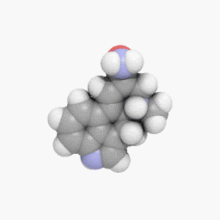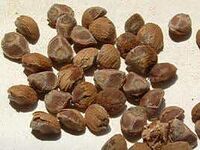LSA: Difference between revisions
>Josikins |
>Josikins |
||
| Line 40: | Line 40: | ||
===[[Cognitive effects - Psychedelics|Cognitive effects]]=== | ===[[Cognitive effects - Psychedelics|Cognitive effects]]=== | ||
The | The cognitive effects of LSA are described by many as extremely relaxing yet lucid and clear headed in its style when compared to other commonly used psychedelics such as [[LSD]] or [[Psilocin]]. Although it is primarily sedating, it is accompanied by fast paced bursts of thought. | ||
LSA contains a large number of psychedelic cognitive effects. The most prominent of these typical effects include: | LSA contains a large number of psychedelic cognitive effects. The most prominent of these typical effects include: | ||
Revision as of 12:48, 7 May 2014
| LSA | |
|---|---|
 | |
 | |
| The skeletal formula of LSA. | |
| Dosage | |
| Differs between Morning glory seeds & Hawaiian Baby Woodrose seeds | |
| Duration | |
| Total duration | 5 - 10 hrs |
| Onset / Initial effects | 20 - 40 mins |
| Coming up | 20 mins - 3 hrs |
| Peak | 2 - 7 hrs |
| Coming down | 1 - 2 hrs |
| After effects | 0 - 3 hrs |
LSA, also known as Ergine, d-lysergic acid amide and d-lysergamide, is a naturally occurring psychedelic alkaloid of the lysergamide family that occurs in many plants such as Morning glory seeds, Hawaiian Baby Woodrose seeds and some species of fungi.
LSA was assayed for human activity by Albert Hofmann in self-trials in 1947 (well before it was known to be a natural compound). Intramuscular administration of a 500 microgram dose led to a tired, dreamy state with an inability to maintain clear thoughts. After a short period of sleep, the effects were gone and normal baseline was recovered within five hours.[1] This suggests that the theory of LSA being the main psychedelic compound within morning glory seeds and Hawaiian baby woodrose is debatable as anecdotal reports suggest that the effects of synthetic LSA and iso-LSA are only slightly psychedelic in their effects and may well be triggered by a mixture of various lysergamides instead of one specific compound.
Chemistry
LSA, or lysergic acid amide, is an alkaloid of the lysergamide family. Lysergamides are distinct from both tryptamines and phenethylamines, although the chemical structure is more similar to tryptamine then phenethylamine.
Pharmacology
LSA acts as a 5-HT1A, 5-HT2A, 5-HT2B, 5-HT2C, 5-HT5 and 5-HT6 partial agonist; the psychedelic effects are believed to come from LSA's efficacy at the 5-HT2A receptors.[2] There is also efficacy at all dopamine receptors and all adrenoreceptors.[3]
Subjective effects
The physical effects of LSA can be broken down into three components all of which progressively intensify proportional to dosage. These are described below and generally include:
- Spontaneous tactile sensations - The "body high" of LSA can be described as a mild yet pleasurable, soft tingling sensation. This is largely noticed in high doses and is accompanied by strong waves of physical euphoria which are usually manifested spontaneously at different unpredictable points throughout the trip but can also maintain a consistent presence. In either case, they steadily rise with the onset and hit their limit once the peak has been reached.
- Sedation - In terms of its effects on the physical energy levels of the tripper, LSA tends to be sedating, however, it can be setting dependent. For example, when taken in settings with large amounts of stimulus or during physically strenuous activities such as walking, running, climbing or dancing it is fully capable of becoming stimulating and energetic. In contrast, however, when taken in calm environments such as darkened rooms with comfortable seating it is consistently relaxing, peaceful and quite sedating.
- Vasoconstriction
The cognitive effects of LSA are described by many as extremely relaxing yet lucid and clear headed in its style when compared to other commonly used psychedelics such as LSD or Psilocin. Although it is primarily sedating, it is accompanied by fast paced bursts of thought.
LSA contains a large number of psychedelic cognitive effects. The most prominent of these typical effects include:
- Connectivity of thought
- Introspection
- Acceleration of thought
- Enhancement of current mind state
- Feelings of fascination, importance and awe
- Conceptual thinking
- Ego suppression, loss and death
- Time distortion
- Direct communication with the subconscious
- Deja-Vu
The visual effects of LSA are mostly present when large doses have been consumed and proportionally mild in comparison to the intensity of its accompanying cognitive and physical effects when compared to substances such as LSD and psilocin.
LSA presents a full and complete array of potential visual enhancements which generally includes:
As for visual distortions and alterations, these are significantly more simplistic from that of open eye distortions found with other psychedelics. Effects experienced are detailed below:
- Drifting (Melting, Breathing, Morphing and Flowing) - In comparison to other psychedelics this effect can be described as mild but highly detailed yet cartoon like in appearance. They are fast yet smooth in motion and fleeting in their permanence. This is an inconsistently manifested effect with some never reporting such effects.
- Colour shifting
The visual geometry that is present throughout this trip can be described as more similar in appearance to that of 4-AcO-DMT, Ayahuasca and 2C-E than LSD or 2C-B. They can be comprehensively described as structured in their organization, organic in geometric style, intricate in complexity, zoomed out and small in size, fast and smooth in motion, colourful in scheme, glossy in colour, blurred in their edges and rounded in their corners. They have a much more "natural" feel to them than LSD and at higher dosages are significantly more likely to result in states of Level 7B geometry over Level 7A.
LSA produces a full range of high level hallucinatory states in a fashion that is very consistent when taken in large doses. The effects of such states include,
- External hallucinations (psychedelic) - These are extremely common within LSA and partially follow the content of the user's current thought process.
- Internal hallucinations (psychedelic) - Unlike LSD, LSA consistently produces moderate to high level hallucinatory states in high doses. This particular effect can be compared to a lucid dream state and commonly contains hallucinations with plots, settings, autonomous entity contact and scenarios. They are more common within dark environments and can be described as internal in their manifestation, lucid in believability, interactive in style and almost exclusively religious, spiritual, mystical or transcendental nature in their overall theme. These hallucinations are complemented by a powerful enhancement of ones ability to visualize concepts. This ability eventually becomes so drawn out proportional to dosage that it leads to full blown hallucinatory states that are entirely lucid and for the most part controllable.
The auditory effects of LSA are common in their occurrence and exhibit a full range of effects which commonly includes:
Forms
Morning glory seeds

The seeds of many species of morning glory contain lysergamide alkaloids such as the psychedelic known as LSA.[4] Though the chemical LSA is not legal in some countries, the seeds are found in many gardening stores; however, it's worth noting that the seeds from commercial sources are often coated in some form of pesticide or methylmercury which can result in extreme nausea if ingested. Seeds without these pesticides can be purchased cheaply online and are freely available.
When using morning glory seeds the dosage for oral consumption is generally considered to be:
- Light : 50 - 100 seeds / 1.5 - 3 g
- Common : 100 - 250 seeds / 3 - 6 g
- Strong : 250 - 400 seeds / 6 - 10 g
- Heavy : 400 + seeds / 10 + g
Hawaiian baby woodrose seeds

Hawaiian baby woodrose is a perennial climbing vine that is native to the Indian subcontinent and introduced to numerous areas worldwide, including Hawaii, Africa and the Caribbean. Hawaiian Baby Woodrose seeds may be consumed for their various lysergamide alkaloids, such as LSA.[5] Although the chemical LSA is not legal in some countries, the seeds are found in many gardening stores; however, the seeds from commercial sources are often coated in some form of pesticide or methylmercury which can result in extreme nausea if ingested. Seeds without these pesticides can be purchased cheaply online and are freely available.
When using Hawaiian Baby Woodrose seeds the dosage for oral consumption is generally considered to be:
- Threshold : 1 - 4 seeds
- Light : 3 - 6 seeds
- Common : 5 - 8 seeds
- Strong : 7 - 12 seeds
- Heavy : 12 + seeds
Toxicity and Harm Potential
Vasoconstriction
LSA should not be used nonstop. When used repeatedly over a short period of time the vasoconstriction effects build up while the psychoactive effects get weaker. If you’re feeling sore legs, this is a sign of the vasoconstriction effects building up in your body.[6] The legs feel sore because not enough blood is getting to the muscles. The upper leg muscles are the largest, most energy consuming muscles in the body, and they will feel sore if blood flow to them is lowered even slightly. If you’ve taken HBWR seeds, morning glory seeds or pure LSA and are experiencing sore legs a well needed break is completely necessary. With LSA it can take up to 3 days of abstinence to get back to vasoconstriction baseline. [7]
Lethal Dosage
The LD50 of LSA for human beings has never been reached in any setting, but is thought to be incredibly high, similar to LSD. There are not any known deaths associated directly with pharmacological causes of LSA, but rather due to self-harm, impaired judgement, and drug interactions.
Tolerance and Addiction Potential
LSA is non-habit-forming and the desire to use it can actually decrease with use. It is most often self-regulating.
An almost immediate tolerance is built to LSA after ingestion, preventing one from experiencing its full effects more often than every 4-7 days, unless they increase their dose significantly.
Legal issues
- Australia: Consumption, sale and possession of LSA is illegal.
- The Netherlands: Consumption, sale and possession of LSA is illegal.
- New Zealand: Consumption, sale and possession of LSA is illegal. The plants and seeds of morning glory species are legal to possess, cultivate, buy, and distribute.
- Sweden: Consumption, sale and possession of LSA is illegal.
- United Kingdom: LSA is a Class A drug, categorised as a precursor to LSD.
- United states: As a precursor to LSD, LSA is a DEA schedule III drug
See Also
References
- ↑ #26. LSD-25 (LA-111, ergine, d-lysergamide) - TIHKAL | http://www.erowid.org/library/books_online/tihkal/tihkal26.shtml
- ↑ COMPARATIVE STUDY ON THE SEROTONIN ANTAGONISM OF AMIDE DERIVATIVES OF LYSERGIC ACID AND OF ERGOT ALKALOIDS | http://jpet.aspetjournals.org/content/122/1/124.short
- ↑ http://molpharm.aspetjournals.org/content/12/4/631.short
- ↑ http://jama.jamanetwork.com/article.aspx?articleid=1165951
- ↑ http://www.sciencedirect.com/science/article/pii/S0379073809004745
- ↑ http://www.ncbi.nlm.nih.gov/pubmed/11128853
- ↑ http://animalsci.highwire.org/content/84/11/3167.short